Notes
Visual Scholars Read the Fake Russian Ads – Part 1
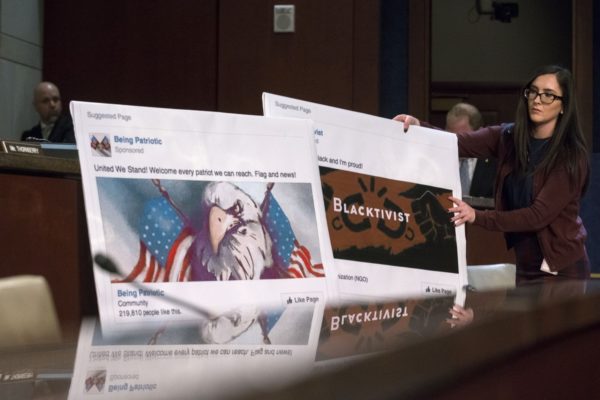
As part of a week of special programming here at Reading the Pictures, we asked seven visual scholars to analyze one of the sponsored ads Russian trolls ran on Facebook during the 2016 presidential election. A special thanks to Katie Irwin for coordinating the effort. In this first installment, Katie looks at the “Army of Jesus” Jesus-Satan arm wrestle. Alyssa Samek takes on the “LGBT United” Buff Bernie Coloring Book. Alex McVey reads an ad by “Being Patriotic” pitting Black Lives Matter against the Boston police. And Thomas McCloskey discusses BM’s “Not My President” poster.
- Army of Jesus (Katie Irwin)
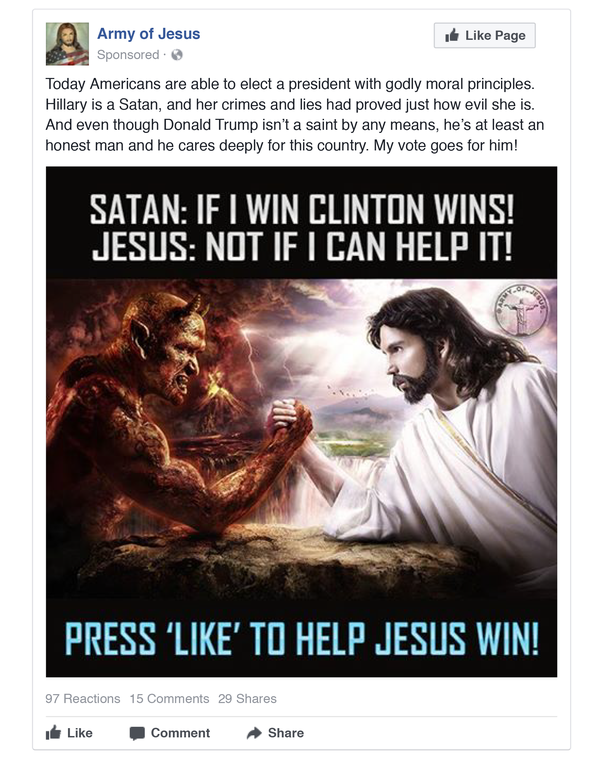
At a price of a paltry $1.10, this “Help Jesus Win!” ad is, financially, the cheapest from this Politico sample. Rubles aside, it asks its targeted audience – Christian adults or those “interested in” Christianity, FOX News viewers, right-wing radio listeners – to make a choice that might be more than they bargained for.
At first glance, the ad activates common tropes of Good vs. Evil. The text directs us to associate Hillary with Satan and Trump with Jesus. Therefore, a vote for Clinton would create a Hell on earth the likes of which the world has never seen before, while a vote for Trump would inaugurate an Edenic paradise. The content and colors corroborate those quick interpretations. The white on the frame’s right connotes cleanliness, purity, virtue – qualities that Christians associate with Jesus. The lush greenery, flowing waterfall, and sun-soaked mountains further picture this as a harmonious habitat for all life forms. Who wouldn’t want to be here? Vote for Trump. By contrast, the lightning, orange flames, and suffocating smoke anticipate an apocalypse that only Clinton’s election would guarantee. Majestic birds do not fly here. Save yourself from the she-devil.
But about that bargain: What makes the ad provocative is the tension in the gender appeals. Consider the human qualities that Trump values: strength, toughness, uncompromising authenticity, aggressiveness. These qualities index heroic masculinity, and he doesn’t like it when his men act like women. Yet the textures of the two figures trouble the textual messages. The billowy white cloth and its smooth lines flow uninterrupted from Jesus’s shoulder to stomach. I look at him and I feel comforted, nurtured. He is the safe space from the jagged, unpredictable chaos that manifests across the devil’s form from finger to forehead. This ad wants viewers to see Clinton when they see Satan. But in the electoral battle of Good vs. Evil, to reject “the devil’s candidate” is also to reject the masculine ideals that this devil embodies.
This ad requires the “Army of Jesus” to dismiss Trump’s worldview and to identify instead with the soft, feminine, conciliatory Christ, because in the end, the characteristics that Trump celebrates — fierce strength, unrelenting toughness, unapologetic hyper-masculinity — inhabit the devil.
2. Buff Bernie (Alyssa Samek)
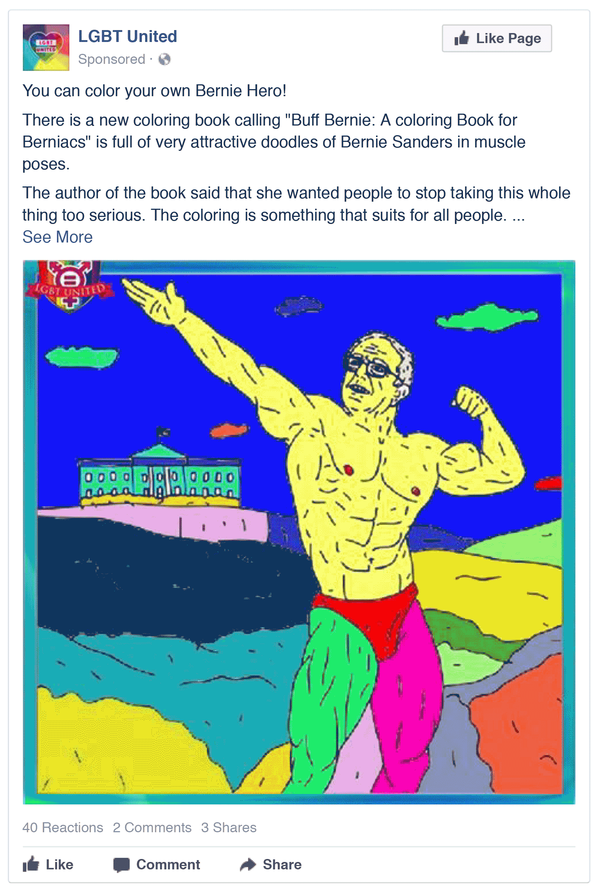
His look suggests he is already a winner. Contrary to his slightly hunched, wispy-white haired frame, the semi-nude body of “Buff Bernie” Sanders commands the foreground of the hand-drawn coloring book image. His muscles ripple from thick neck and pectorals to 6-pack abdominals to huge quadriceps, interrupted only by a red bikini brief.
At first glance, the hypermasculine Buff Bernie cuts a frame similar to another bodybuilding politician, Arnold Schwarzenegger. Yet the rainbow colors, the muscled, bikini-clad body, and the graphic in the upper corner featuring a transgender symbol overlaid with an equal sign and “LGBT UNITED” suggest additional layers of meaning.
That the image was used to promote “Buff Bernie: A Coloring Book for Berniacs” and posted on LGBT United’s Facebook community necessitates a queer reading. The range of colors references the pride rainbow. Buff Bernie draws upon men’s muscle magazines of decades past and the expectations within gay men’s culture to sport toned and rippled bodies.
In this image, then, Sanders is a heroic queer figure. These references invite LGBTQ audiences, and specifically gay men of all ages, to identify with Sanders’s hypermasculinity and view Sanders as a hero for the movement. Furthermore, while the image identifies “the queer vote” as up for grabs in the 2016 Democratic primary, it plays upon long-standing divisions between gay men and lesbian women in the LGBTQ movement as the muscled, rainbow Sanders calls upon gay “Bernie Bros” to divide the queer vote along gendered lines.
3. Being Patriotic (Alex McVey)
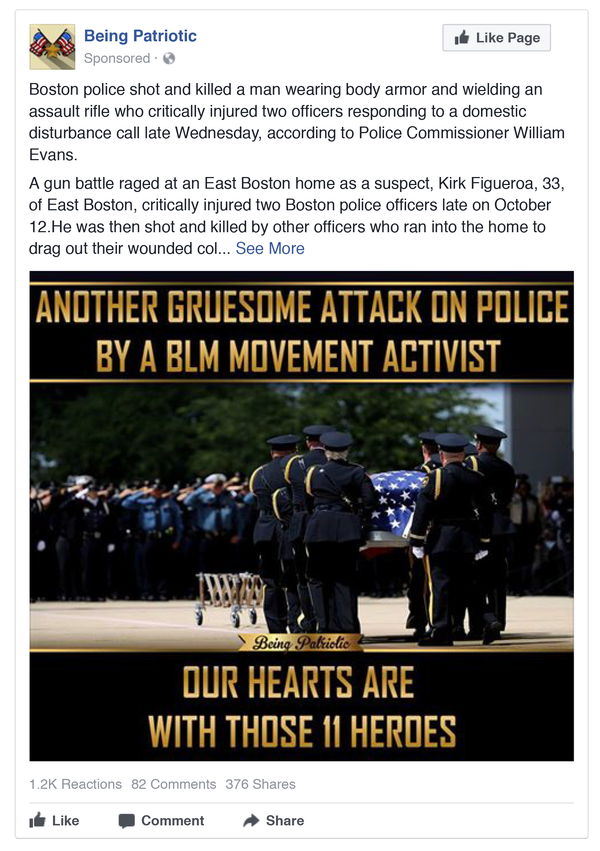
The viewer of this image is situated alongside mourning bodies draped in blue. The state funeral, flag-draped coffin, and arms saluting their fellow fallen officer all signal the loss of a Blue Life that was always grievable, whose mattering has never been in question. The low camera angle positions the viewer in a scene of grief, but also one of grievance. The grievance politics of the Blue Lives Matter movement depict the brotherhood of Blue Lives as under constant attack from those outside the frame, the forces of evil which have sent this hero to an early grave.
The visual iconography of the Blue Lives Matter movement crafts an antagonistic social relationship out of its response to the claim that Black Lives Matter. It does so, in part, by visually linking physical assaults on police officers with any criticism of police by activists, media, and politicians. Even the most even-handed and moderate of reformist discourses become connected to images of police bodies in distress. The visual rhetoric of the “War on Cops” trope not only flattens the distinctions between critiques of the police, it renders all critique into attack, thus shutting down the possibility of discussion and debate. To be patriotic, in this image, is to pick a side: the side of the cops, or all of those who choose war against them.
The visual conflict inherent to this demand is especially well-suited to the rhetorical politics of strong-man authoritarianism. It is not simply that Russian social media influencers invented an antagonism out of thin air. Instead, these Russian media laborers knew that visual signifiers of police were a powerful site for articulating the kinds of white grievance which would drive Americans towards the simplistic, us vs. them narratives which were a mainstay of Donald Trump’s broader rhetorical signature. By depicting Hillary Clinton as the vanguard of the liberal culture war on patriotic American values, social media posts like this one became online sites of emotional investment in the grievance politics which Trump successfully tapped into on his way to the Presidency.
4. Not My President (Thomas McCloskey)
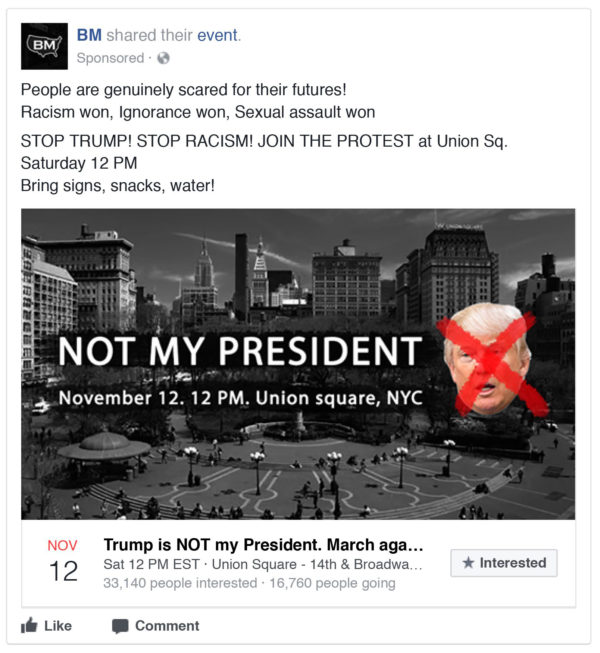
This image of a fake Facebook Event advertisement calls on residents of New York City to join a protest in response to Donald Trump’s election victory just days earlier. It encourages audiences to reject the legitimacy of Trump’s presidency because it is an affront to American values.
This picture, and the fake event invitation itself, underscores a common misconception regarding the efforts by Russian intelligence agencies to influence American politics and public life. The Russian Government is not and was not “pro-Trump” specifically, but rather it was acting in whatever manner would create the most uncertainty and undermine American leaders and America’s standing in the world.
Such propaganda campaigns are designed to create chaos and undermine institutions rather than promote one candidate or another. The Russian government benefits from an American president who waivers on support for NATO, fails to support Ukrainian efforts to resist Russian separatists within its borders, and generally pulls America back as a global leader. However, the Russian government benefits more from an American civil society that is intractably polarized and unable to agree on the legitimacy of its own electoral process or of its leadership, since these divisions might permanently prevent any united American resistance to Russian actions around the world.
The image reflects a larger Russian propaganda strategy of short-circuiting American civil society itself, something far more nefarious and far-reaching than the simple hacking of emails. Amateurs rig elections; professionals break institutions and public life so that elections do not matter.
Katie Irwin is an independent scholar living and writing in Portland, Oregon. She earned her Ph.D. in Communication from the University of Illinois at Urbana-Champaign, where she taught courses on Visual Politics.
Alyssa Samek, Ph.D. is an Assistant Professor of Human Communication Studies at California State University, Fullerton. Her work examining rhetoric, sexuality, gender, LGBTQ histories, and feminism has appeared in the Quarterly Journal of Speech, Communication and Critical/Cultural Studies, and Women’s Studies in Communication.
Alex McVey is a PhD Candidate in the Department of Communication at the University of North Carolina at Chapel Hill. His current project, Policing the Post-Racial: A Visual Rhetoric of the Blue Lives Matter Movement, examines the online visual culture of the Blue Lives Matter movement as a site of white cultural backlash to the Obama presidency and the Black Lives Matter movement.
Dr. Thomas McCloskey teaches rhetoric and political culture at the University of Maryland. He successfully defended his dissertation, “Cold War II: Ukrainian Sovereignty and Identity,” in November 2017.
See Visual Scholars Read the Fake Russian Ads Part 2 here.
***
This week, we at Reading the Pictures are asking for your support. We are the rare organization promoting both visual literacy and media literacy. Help sustain our role as vigorous advocates for effective news and concerned photography with a tax-deductible donation at the bottom of the post or the lower far right of this page.
(Ads via The House Intelligence Committee. Lead photo: Shawn Thew/EPA/Rex/Shutterstock Caption: Examples of Facebook pages created by the Russian troll factory are displayed during a House intelligence committee hearing on Wednesday.)
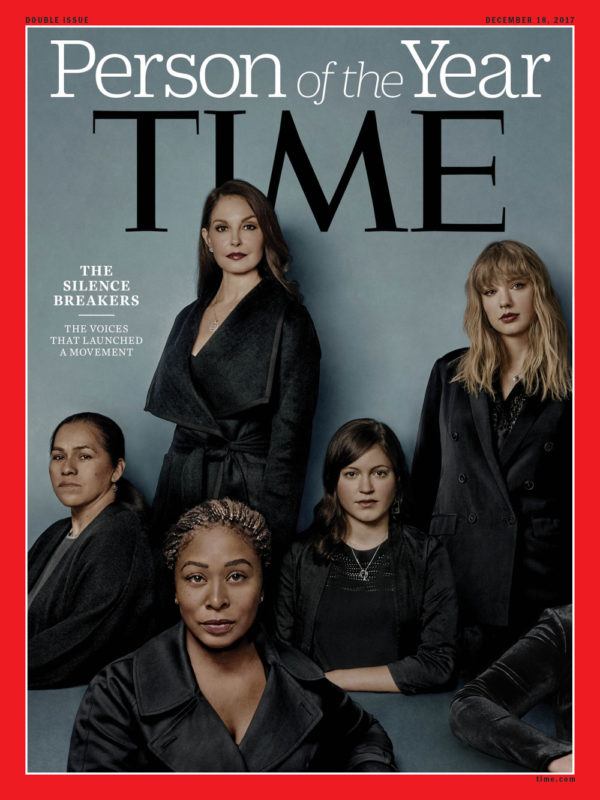
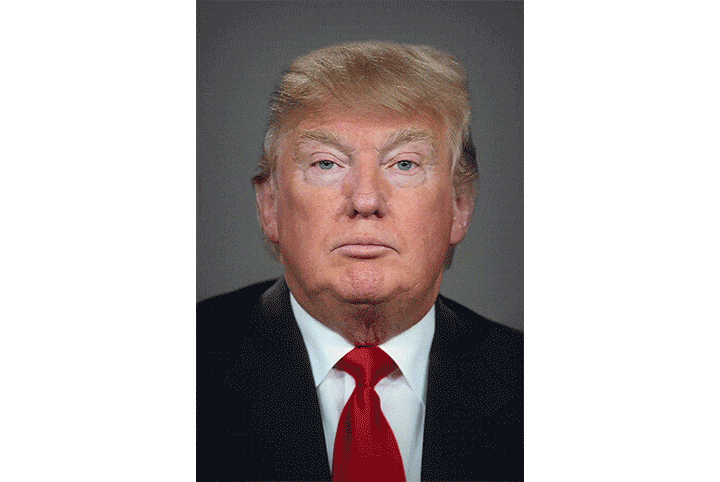
Reactions
Comments Powered by Disqus